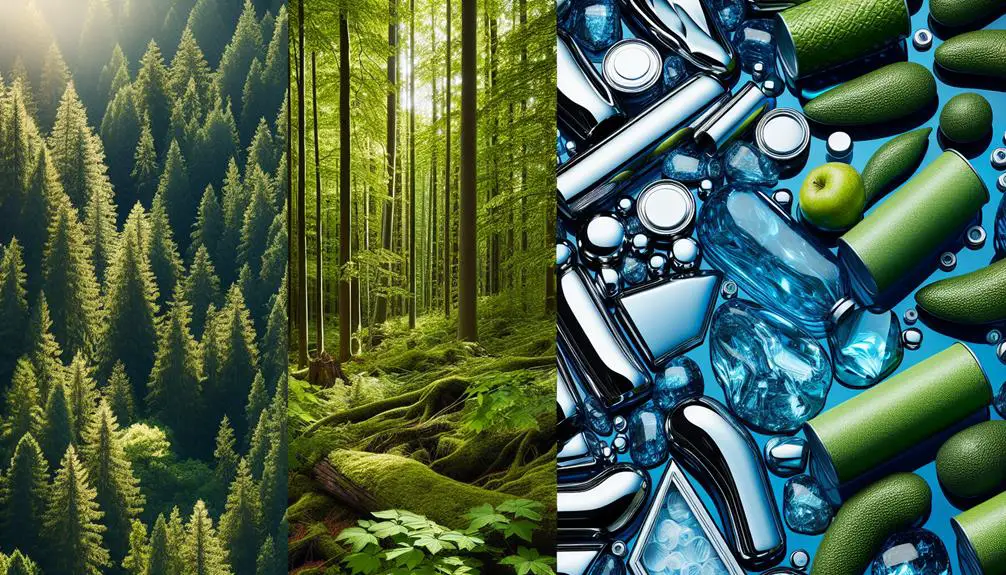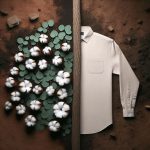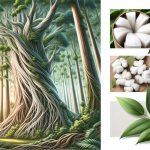Nope, Tencel Lyocell isn't plastic. It's actually a fiber made from wood pulp, which comes from sustainably sourced trees. Unlike synthetics that are plastic-based, Tencel Lyocell is fully biodegradable. It's got a closed-loop production process, meaning it reuses water and solvents, cutting down waste and energy use. What's cool is that it's not just eco-friendly, but also breaks down naturally in the environment. And, it's super comfy and trendy in fashion circles for its softness and breathability. If you're curious about how it fits into more sustainable lifestyles, there's plenty more to uncover.
Table of Contents
Key Takeaways
- Tencel Lyocell is derived from renewable wood pulp, not synthetic or plastic materials.
- Unlike plastics, Tencel Lyocell is fully biodegradable under composting conditions.
- The production of Tencel Lyocell involves natural materials and eco-friendly processes.
- Tencel Lyocell fibers break down naturally, contrasting with non-biodegradable plastics.
- It is crafted using sustainably sourced wood, emphasizing its natural origin over plastic.
Understanding Tencel Lyocell
Tencel Lyocell is often praised for being an eco-friendly alternative to synthetic fibers, as it comes from easily renewable wood pulp and not plastic. This material is a standout because it's derived from cellulose found in wood pulp, making it inherently biodegradable. That's right, Tencel isn't just kind to your skin but also to the planet! It breaks down naturally without leaving nasty pollutants behind, unlike some synthetic materials that can linger in our environment for centuries.
This fiber's environmental benefits don't stop at its source. Tencel Lyocell is produced through an environmentally responsible closed-loop production process. This means that the solvents used to turn wood pulp into cozy fibers are recycled over and over again. It's a neat circle that reduces waste and harmful emissions. As someone who's really into sustainable living, I find this super impressive!
Furthermore, the strong yet gentle nature of Tencel makes it ideal for sustainable textile applications. Whether it's in your soft bed sheets or that comfy tee, it ensures durability without compromising on comfort. So, Tencel isn't just good news for the environment; it's great for our wardrobes too!
The Production Process
Now, let's explore how Tencel Lyocell is actually made. The journey begins with sustainably sourced wood, which is crucial since we're aiming for an environmentally friendly product. This wood is transformed into pulp, setting the stage for its next big transformation.
In the heart of Tencel's creation is the solvent spinning process. Here, the wood pulp is dissolved in a non-toxic solvent through chemical processing. What's cool about this is the closed loop production process. Essentially, this means that the solvent is recycled back into the system, minimizing waste and reducing harmful emissions. It's a smart way to keep things clean and efficient.
Once the pulp is fully dissolved, it's pushed through tiny holes to form fiber strands. These strands are then chemically treated, washed, and dried to produce the soft, versatile fibers known as Tencel. Compared to traditional fibers like cotton, this process uses significantly less energy and water.
Plus, Tencel isn't just kind to the planet during production. It's also biodegradable and compostable, breaking down naturally once it's outlived its use. This is a stark contrast to synthetic fibers, which often end up in landfills. So, Tencel vs. traditional materials? Tencel carries the eco-friendly trophy.
Environmental Impact
When I look at Tencel Lyocell, its biodegradability stands out as a major plus. It breaks down naturally, unlike synthetic fibers that can linger in our ecosystem.
Also, its production is quite efficient, using way less water and energy than materials like cotton.
Biodegradability of Tencel Lyocell
As we explore the environmental impact, it's clear that the biodegradability of Tencel Lyocell plays a crucial role in reducing waste and pollution.
Unlike many materials that clog our landfills, this eco-friendly fiber, made from wood pulp, breaks down under composting conditions. It's comforting to know that Tencel Lyocell won't just sit in a dump for centuries. Instead, it returns to nature, decomposing in soil or water without leaving harmful residues.
This characteristic is especially important as we shift towards sustainable fashion and more conscious consumer choices. Embracing materials like Tencel Lyocell, which align with our eco-goals, is essential for minimizing our environmental footprint and promoting a cleaner, greener planet.
Production Resource Efficiency
While Tencel Lyocell's biodegradability significantly reduces its ecological footprint, the way it's produced also sets a high standard for resource efficiency. The production process is not just about using wood pulp; it's about doing so responsibly. They use eco-friendly chemicals and a closed-loop system that recycles water and recovers solvents, which means nearly everything gets reused.
Here's a quick snapshot:
| Resource | Usage in Tencel Production | Comparison to Conventional Methods |
|---|---|---|
| Water | Significantly less | Less than conventional cotton |
| Energy | Lower consumption | More efficient than viscose |
| Chemicals | Eco-friendly, recoverable | Safer than traditional viscose |
This approach not only conserves energy and water but also minimizes the environmental impact, aligning with the eco-conscious goals many of us strive for.
Comparison With Synthetic Fibers
In contrast to synthetic fibers like polyester or nylon, Tencel Lyocell is crafted from naturally sourced materials and is fully biodegradable. I'm excited to delve into why Tencel Lyocell stands out as a sustainable alternative in the fashion industry, especially when lined up against common synthetics.
Firstly, Tencel Lyocell's roots in natural materials—notably sustainably sourced wood pulp—make it a beacon of eco-friendly production. It's not just about being natural, but also about how these resources are harvested and transformed in an environmentally responsible way. This is crucial because it reduces the ecological footprint from the get-go.
Here's a quick breakdown of Tencel Lyocell's benefits over synthetic fibers:
- Eco-friendly Manufacturing: Processes used to create Tencel Lyocell minimize harmful impacts, unlike the often chemical-intensive production of synthetics.
- Sustainable Sourcing: The wood pulp comes from certified forests, ensuring sustainable growth and harvesting practices.
- Biodegradable Properties: Unlike plastics-based fibers, Tencel Lyocell breaks down naturally, adding to its environmental creds.
Biodegradability and Compostability
Now, let's look at how quickly Tencel Lyocell breaks down and its composting process.
It's impressive how this fabric can be composted both at home and in industrial settings, which is great for reducing waste.
I'll explain the degradation rates and how you can compost Tencel Lyocell fabrics effectively.
Tencel Lyocell Degradation Rates
Tencel Lyocell breaks down naturally and quickly compared to synthetic fabrics, making it a great choice for environmentally conscious consumers. Its biodegradable nature ensures that when it degrades, it doesn't leave behind harmful residues, unlike many synthetic materials. The degradation rates are impressive, making Tencel not only eco-friendly but also practical for those looking to minimize environmental impact.
- Biodegradable: Breaks down naturally without releasing harmful substances.
- Compostability: Can be composted, enhancing its eco-friendly credentials.
- Eco-Friendly: Degradation doesn't compromise environmental health.
Composting Tencel Lyocell Fabrics
One can appreciate that Tencel Lyocell fabrics aren't only biodegradable but also fully compostable, making them a smart choice for eco-conscious individuals. When you toss them into a compost bin, they break down into organic matter, contributing positively to the circular economy. This process mirrors nature's own recycling system, aligning perfectly with sustainable waste management efforts.
The environmental impact of using Tencel Lyocell is significantly lower than that of non-biodegradable materials. By composting these fabrics, you're stepping into a loop where every end is a new beginning. It's all about minimizing waste and maximizing resource efficiency. Truly, embracing Tencel Lyocell is a stride towards better, more sustainable living practices.
Applications in Fashion
In the world of fashion, Tencel lyocell has become a popular choice for its eco-friendly qualities and superior comfort. As someone deeply interested in sustainable fashion, I've noticed that this fabric isn't just about being kind to the planet; it's also about delivering on style and functionality. Tencel lyocell, known for its soft texture and high-quality feel, offers a breath of fresh air in the fashion industry.
Here's why Tencel lyocell is a standout in fashion applications:
- Versatile Fabric: Whether it's sleek activewear, comfy lingerie, or stylish womenswear, Tencel lyocell fits beautifully into various clothing categories.
- Eco-friendly Production: The production process of Tencel lyocell is designed to be environmentally responsible, reducing harmful impacts and using resources efficiently.
- Superior Comfort: Its moisture-wicking properties and breathability make it ideal for clothing that feels good on the skin and performs well in different environments.
The global acceptance of Tencel lyocell by leading designers and retailers further underscores its versatility and commitment to eco-conscious practices. It's exciting to see how this fabric is shaping the future of fashion, making it both chic and sustainable.
Care and Maintenance Tips
Having covered its use in fashion, let's now look at how to keep Tencel lyocell looking great with some simple care and maintenance tips. Firstly, it's important to know that Tencel lyocell is made from natural wood pulp, which is sourced responsibly. This makes the fabric not only environmentally friendly but also wonderfully soft, similar to cotton.
When you're washing Tencel lyocell products, stick to cold water. Hot water can be harsh on the fibers and might cause them to shrink. I always use the gentle cycle on my washing machine to keep the fabric in top shape. Avoid bleach since it can break down the natural fibers, reducing their lifespan and softness.
For drying, air-drying is your best bet to preserve its qualities. If you're in a hurry, a tumble dryer on a low heat setting works, but make sure you don't overdo it. Over-drying can make the fabric stiff and can lead to shrinkage.
If you notice any wrinkles, ironing on a low heat while the fabric is still damp can do wonders. This helps smooth out the fabric without harming it. Lastly, store your Tencel items in a cool, dry place away from direct sunlight to avoid fading and to maintain their quality over time.
Frequently Asked Questions
Does Tencel Have Microplastics?
No, Tencel doesn't have microplastics. It's made from wood pulp and biodegrades naturally. This makes it a great choice for reducing environmental impact compared to synthetic fibers that release microplastics when washed.
Is Lyocell a Plastic Fabric?
No, Lyocell isn't a plastic fabric; it's made from natural cellulose, which is biodegradable. Unlike plastics, it doesn't create microplastic pollution, making it an environmentally friendlier option for textiles.
What Kind of Material Is Tencel Lyocell?
Tencel Lyocell is a semi-synthetic fiber made from eucalyptus wood pulp. It's known for being soft, breathable, and eco-friendly because it's biodegradable and produced in a sustainable, closed-loop process.
Is Tencel Lyocell Environmentally Friendly?
Yes, I think Tencel Lyocell is environmentally friendly. It's made from sustainable wood sources, uses less water and energy, and its production process minimizes waste and chemical use. Plus, it's biodegradable!
- Is Suede a Good Fabric for a Sofa? Pros and Cons - July 12, 2025
- Using Fabric Paint on Suede: A How-To Guide - July 12, 2025
- Can You Dye Suede Shoes With Fabric Dye? the Answer - July 12, 2025







